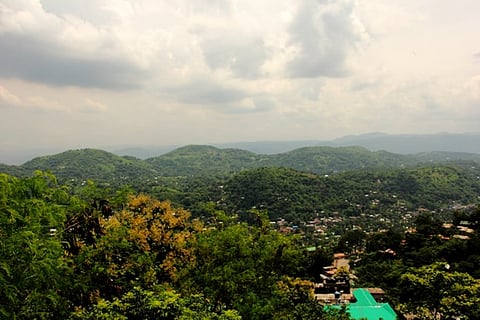
- Home
- Live Blog
- Breaking News
- Top Headlines
- Cities
- NE News
- Sentinel Media
- Sports
- Education
- Jobs

Ananya Gogoi
(ananyagogoi@gmail.com)
Nestled in the heart of Assam, Guwahati is a city steeped in ancient heritage and cultural dynamism. With roots embedded in religious texts like the Kalika Purana and Yogini Tantra, Guwahati holds historical significance that is palpable in its many sacred sites. The Maa Kamakhya Temple, a revered centre of Shakti worship, along with numerous Ahom-era monasteries and temples, echoes stories of devotion and history, attracting pilgrims and tourists alike.For centuries, Guwahati has thrived as a spiritual and cultural hub, showcasing a rich landscape of traditions and practices that continue to shape its identity today.
Beyond its spiritual allure, Guwahati has played a pivotal role in India’s journey toward independence. The city became a crucial centre during the British colonial era, fostering educational institutions and laying down administrative frameworks that have left an indelible mark on its landscape. Today, Guwahati embodies resilience and adaptability, having weathered the storms of time and emerged as a vibrant metropolis, rich in culture and steeped in history.
The transformation of Guwahati gained significant momentum when the capital shifted temporarily from Shillong, resulting in an influx of people and resources. This demographic surge catalysed rapid urban growth, but with it came challenges typical of urbanization. Unlike meticulously planned satellite towns, Guwahati’s organic growth resulted in pressing urban issues, most notably the crippling traffic congestion and inadequate infrastructure. Over the years, the city has grappled with infrastructure improvements that lagged behind its rapid growth, leaving residents feeling the brunt of these challenges.
However, in the last three years, the city has embarked on a transformative journey, with government initiatives aimed at establishing Guwahati as the “Gateway to Southeast Asia.” A range of infrastructure projects has been undertaken to tackle traffic woes head-on. Notable developments, such as flyovers at Supermarket, Arya Nagar, Maligaon, and RG Baruah Road, are beginning to ease congestion significantly. The under-construction four-lane flyover, stretching 5.05 km from Dighalipukhuri to Noonmati’s FCI godown at an investment of approximately Rs. 852.68 crores, promises to further alleviate the city’s traffic challenges upon completion. The expansion efforts continue with the construction of flyovers on GS Road near Downtown Hospital and over Garbhanga Road connecting the Cycle Factory to Lalganesh. Meanwhile, the construction of the Guwahati-North Guwahati and Palashbari-Sualkuchi bridges, in conjunction with the completion of the Ring Road, is set to redefine the city’s identity.
To streamline traffic flow, a state-of-the-art integrated monitoring system is being introduced, enabling real-time oversight of traffic signals and vehicle movement through CCTV technology. Guwahati’s natural beauty, particularly along the majestic Brahmaputra River, offers immense potential for tourism development. Strengthening ferry services and enhancing water transport infrastructure are vital to unlocking this potential. The development of modern river terminals at North Guwahati and Umananda Ghats promises to facilitate smoother water transport, enticing tourists to explore the city’s scenic and cultural attractions.
However, challenges remain. Many roads and by-lanes in Guwahati suffer from inadequate lighting at night, raising safety concerns for residents. The installation of smart LED streetlights is poised to address these issues, contributing to a reduction in crime rates associated with poorly lit areas and improving overall public safety. Programs like the Brahmaputra Riverfront Development Project, part of the Guwahati Smart City initiative, guide the city toward a brighter, more efficient future.
Cultural sites such as the Srimanta Sankaradeva Kalakshetra have received much-needed revitalization, while religious institutions like the Dakhinpat Satra, Aswaklanta, and Umananda are also being beautified, infusing new life and energy into the city. Moreover, there is a growing recognition of the need for mental and physical development opportunities for children in urban settings. The recent push to create green spaces and parks has started to address this gap. The government has initiated plans to refurbish existing parks and create new ones, transforming spaces into vibrant community hubs. The botanical gardens established at Amrit Udyan in Hengerabari, Atal Udyan in Adabari, and the Old Jail site, as well as new parks like Jorpukhuri Park in Uzan Bazar, Nehru Park in Panbazar, Swahid Udyan in Fatasil, and Borsola Kreeda Udyan in Paltan Bazar, offer residents open spaces for relaxation and recreation.
As these multifaceted initiatives unfold, Guwahati is poised to solidify its status as the “Gateway to Southeast Asia,” where tradition meets innovation and urban challenges are met with strategic solutions. The city’s rich heritage and cultural vibrancy continue to flourish, promising an exciting future for its residents and visitors alike. In this melting pot of history and progress, Guwahati stands as a tribute to resilience, adaptability, and the power of community-driven growth.